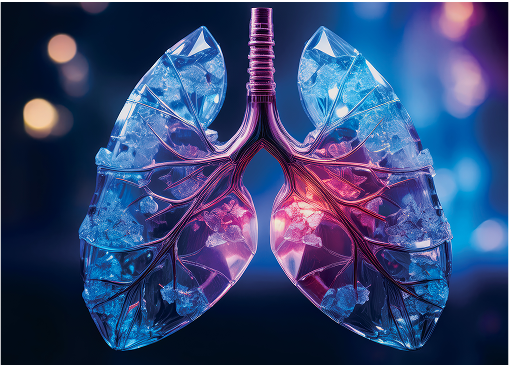What is Non-Small Cell Lung Cancer (NSCLC)?

Non-Small Cell Lung Cancer (NSCLC) is the most common type of lung cancer, accounting for about 85% to 90% of all lung cancer cases. It is a group of lung cancers that behave similarly and are treated in similar ways. NSCLC is different from small cell lung cancer (SCLC), which is less common and tends to grow and spread more quickly.4
How Lung Cancer Develops1
Normally, the cells in our lungs and other parts of our body have a specific growth and death cycle that keeps the number of cells in check. Cancer, of any kind, develops when a set of specific changes, called mutations, develop in a previously normal cell. When the set of mutations affects genes in ways that change the natural growth and death cycles of cells, unregulated cell division can result in too many cells. It's like a car when the gas pedal gets stuck or the brakes don’t work—the cells just keep dividing with nothing to stop them.
The mutated and abnormally multiplying cells form a mass called a tumor, neoplasm, or lesion. In the case of lung cancer, this mass might be detected as a nodule on a chest X-ray or CT scan. The mass can be benign, or it can be malignant.
When the tumor cells can invade normal tissues, the tumor is considered to be malignant. When the malignant cells originally come from the lung, the tumor is considered to be lung cancer.2
Spread of Cancer
The spread of cancer from one part of the body to another is known as metastasis, and the tumors formed by those cancer cells that have spread are called metastases. Lung cancer metastases can spread to lymph nodes around the lungs, and they can also travel through the bloodstream to other organs, such as bones, the adrenal glands, and the brain.2
Sometimes cancer starts in other parts of the body and spreads to the lung. That is considered metastasis of the original type of cancer, not lung cancer. Only cancer that starts in the lung is considered lung cancer.2
Types of Lung Cancer1
Lung cancer can be classified in two ways, either by its histology (what the cells and tissue look like under a microscope) or by its biomarkers (genes or proteins whose activity becomes altered in cancer).
Because each type of lung cancer behaves and is treated differently, it helps to have as much information as possible about a person’s individual lung cancer. To get that information, it is necessary to have tumor tissue samples for a careful review to determine the most accurate information.
Non-Small Cell Lung Cancer (NSCLC)4
Non-small cell lung cancer is a type of cancer that forms in the tissues of the lung.
There are several types of non-small cell lung cancer. Each type of non-small cell lung cancer has different kinds of cancer cells. The cancer cells of each type grow and spread in different ways. The types of non-small cell lung cancer are named for the kinds of cells found in the cancer and how the cells look under a microscope:
- Adenocarcinoma is a type of lung cancer that begins in the cells that line the alveoli and make substances such as mucus.
- Squamous cell carcinoma is a type of lung cancer that forms in the thin, flat cells lining the inside of the lungs. This is also called epidermoid carcinoma.
- Large cell carcinoma is a type of lung cancer that may begin in several types of large cells.
Stages of Non-Small Cell Lung Cancer4
Cancer stage describes the extent of cancer in the body, such as the size of the tumor, whether it has spread, and how far it has spread from where it first formed. It is important to know the stage of non-small cell lung cancer to plan the best treatment.
The following stages are used for non-small cell lung cancer:
Occult (hidden) stage (tumor cells in sputum, but tumor is not visible on imaging), Stage 0 (carcinoma in situ, no tumor cells spread to nearby tissue), Stage I NSCLC (small tumor localized to one area); Stage II NSCLC (larger tumors orthose that have grown more deeply in nearby tissue) ; Stage III NSCLC (the cancer has grown more extensively within the primary site or may have spread to nearby lymph nodes or tissues) and Stage IV NSCLC (the cancer has spread to other parts of the body).
- Lungevity Foundation. Lung Cancer Basics. https://www.lungevity.org/lung-cancer-basics. Updated February 12, 2024. Accessed 3 June, 2025.
- Non-Small Cell Lung Cancer Treatment (PDQ®)—Patient Version. National Cancer Institute website. https://www.cancer.gov/types/lung/patient/non-small-cell-lung-treatment-pdq. Revised January 29, 2024. Accessed 3 June, 2025.
- Key Statistics for Lung Cancer. American Cancer Society website. https://www.cancer.org/cancer/types/lung-cancer/about/key-statistics.html
- What is Non-Small Cell Lung Cancer? American Cancer Society website. https://www.cancer.org/cancer/types/lung-cancer/about/what-is.html Revised January 29, 2024. Accessed 3 June, 2025.
Explore Studies in NSCLC
All BMS Non-Small Cell Lung Cancer Trials
BMS-NSCLCTrials.com Back to Top
Back to Top